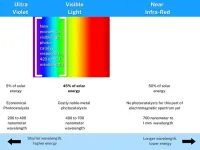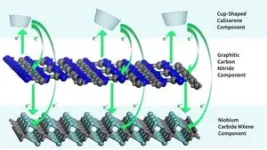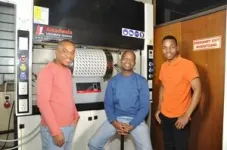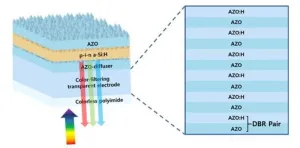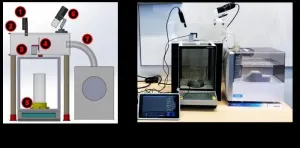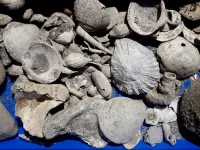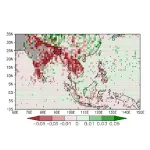(Press-News.org) A new type of versatile economical photocatalyst that harnesses the visible portion of the sunlight spectrum has been developed by researchers from the University of Johannesburg. It is simple to manufacture.
Currently, economical photocatalysts only ‘use’ the UV spectrum of sunlight.
The new photocatalyst harnesses about a third of the visible light spectrum.
The extremely stable, powder-form three-component photocatalyst is built from graphitic carbon (89% of mass), a modified calixarene (10%) and a niobium-containing MXene (1%).
Researchers at the University of Johannesburg have developed a new type of photocatalyst that harnesses the visible portion of the sunlight spectrum. Currently, economical and environmentally-friendly photocatalysts only ‘use’ the UV spectrum of sunlight, example the commonly-used titanium dioxide and other close equivalents.
The research is published in Journal of Science: Advanced Materials and Devices.
The photocatalyst is the first three-component photocatalyst with these specific photocatalytic properties. It is almost 90% comprised of economical off-the-shelf ingredients, and simple enough to produce at scale in resource-constrained laboratories.
In other research studies, a photocatalyst containing the noble metal palladium (Pd) has been described, which ‘uses’ the visible spectrum of sunlight also.
In contrast, the photocatalyst in this study uses small amounts of the minor transitional metal carbide, niobium to prepare the third component, a nanomaterial known as a MXene.
Niobium carbide MXene has been used in a wide array of photocatalytic applications such as hydrogen generation and carbon dioxide conversion to valuable products.
In powder form, the photocatalyst is also extremely stable under high temperatures, humidity, and chemical variations.
The catch with photocatalysts
Reducing energy use in bulk industrial processes can be tricky. But what if a major portion of the electrical energy consumed, can be ‘clawed back’ by the sun instead?
Photocatalysts can be ‘switched on’ by sunlight and other forms of light. These can then facilitate chemical processes by orders of magnitude. These catalysts exhibit potentials to be used in a variety of energy generation and environmental detoxification industries.
But there is a catch. Currently, highly effective photocatalysts tend to be very expensive. Also difficult and even dangerous to make.
A major component of the cost of photocatalysts can be metals such as platinum, palladium or gold. Using metals in photocatalysts is not desirable from an environmental point of view either.
Another catch is that most current photocatalysts tend to ‘switch on’ mostly upon UV light exposure, which only constitutes 5% of sunlight energy reaching the surface of the Earth.
Meanwhile, visible light constitutes 45% of the available solar light energy, and near-infrared the remaining 50%.
Adding a third of visible light spectrum
The photocatalyst the researchers designed and tested harnesses about a third of the visible light spectrum, says Prof Langelihle (Nsika) Dlamini. Dlamini is a researcher at the UJ Department of Chemical Science.
To put numbers on this, the ultraviolet spectrum (UV) has shorter wavelengths (high energy), ranging from 200 to 400 nanometers. Visible sunlight has longer wavelengths (low energy) from 400 to 700 nanometers.
The violet-blue-cyan-green portion of visible sunlight right next to UV light, is what the UJ researchers’ photocatalyst responds to. This low-energy portion of visible light also ‘switches on’ the photocatalyst to initiate chemical reactions.
“The photocatalyst is excited and has a low rate of undesirable electron and holes recombination in the 420 to 520 nanometer wavelength range. This is owing to the unique structural design of the integrated materials,” says Dlamini.
“This means that the photocatalyst should be able to respond to an additional 15% of the available solar energy to initiate chemical processes, depending on its efficiency,” he says.
First economical and stable visible spectrum photocatalyst
This study is a first for a non-noble metal, economical photocatalyst, says PhD candidate Mr Collen Makola.
“The performance of any photocatalyst can be measured by evaluating its ability to convert solar and/or light energy into chemical energy. This is known as the photo-to-chemical conversation efficiency, represented as mu.
“Our photocatalyst (mu= 4.86%) surpasses a three-component photocatalyst (mu = 1.81%), which appeared in a journal article in 2017. That photocatalyst was composed of silver, cadmium sulfide, and zinc oxide,” says Makola.
In temperature tests, the researchers found that the photocatalyst is extremely stable up to 500 degrees Celsius. Also, the stability in water of different pH levels was confirmed ranging from pH 1 to pH 14.
Additionally, the prepared photocatalyst disperses uniformly in water—an added advantage for photocatalytic applications.
Three-ingredient, almost metal-free
To get a photocatalyst with this performance, the researchers combined three ‘ingredients’ for the final design of the photocatalyst.
First, about 89% of the bulk mass of the powder-form photocatalyst is graphitic carbon, says Dlamini.
“Graphitic carbon is ‘excited by’ or ‘switched on’ by UV light in the 200 to 400 nanometer wavelength range. It produces free electrons that can then initiate a variety of chemical processes,” adds Dlamini.
The researchers produced this ingredient at one of the UJ laboratories.
The second ingredient is about 10% of the final mass. This is the calixarene, in this case a cup-shaped molecule.
“We included the calixarene so the photocatalyst can ‘catch’ and break down unwanted organic molecules, such as personal products, pharmaceutical drugs and their metabolites and other substances in municipal wastewater. Calixarenes have been used for decades in pharmaceutical drugs,” adds Dlamini.
The researchers purchased the calixarene off-the-shelf and then modified it.
The third ingredient is the MXene.
“The main function of the MXene is to prevent the photo-generated electrons from the graphitic carbon nitride to recombine or ‘cancel out’ with the positively charged species (known as holes) under visible light exposure,” says Makola.
The MXene they selected is about 1% of the final mass. It contains carbon and a tiny amount of niobium, a relatively low-cost metal.
“Both the calixarene and the MXene contributed to shifting of the light absorption into the visible region of the solar spectrum,” says Makola.
Versatile, multiple applications
By its very nature, the economical photocatalyst has significant potential for multiple industrial applications where sunlight or electrical light is available to facilitate chemical processes, says Dlamini. This varies from bulk water treatment to sterilisation of grow rooms or medical facilities and more.
Currently, the researchers are testing the photocatalyst’s ability to break down organic pollutants and pharmaceutical residues in real wastewater samples at laboratory scale.
###
Funding
The researchers thank the University of Johannesburg (URC) and Faculty of Science (FRC), National Research Foundation - CSUR (Grant SRUG210223587616), National Research Foundation and the German Academic Exchange Service (NRF-DAAD) for research and study financial support.
Notes to Editors:
Media Pack
For high resolution images, go to
https://drive.google.com/drive/folders/1puls0BJhlKIYIjLB8HoNJfEcmVrD_5hv?usp=sharing
No registration or login necessary from a computer.
For more information, or to speak to the researchers involved, please contact:
Ms Therese van Wyk, Research Media Liaison, University of Johannesburg, +27 71 139 8407 (Mobile and Whatsapp), theresevw@uj.ac.za.
END
New type of visible-light responsive photocatalyst is efficient, stable and very economical
2023-08-28
ELSE PRESS RELEASES FROM THIS DATE:
Low cost, high efficiency, multiple colors at the same time!
2023-08-28
A research team led by Dr. Jung-dae Kwon from the Department of Energy & Electronic Materials at the Korea Institute of Materials Science(KIMS) has succeeded in realizing the world's first transparent thin-film solar cell on a flexible substrate that exhibits different reflective colours and does not significantly reduce solar cell's efficiency. KIMS is a government-funded research institute under the Ministry of Science and ICT.
This is a technology that achieves reflective colour only a single material by periodically incorporating hydrogen into zinc oxide material doped with aluminium, which is a transparent electrode, to induce a refractive index difference. ...
New guidance on take-home naloxone for community overdose responders
2023-08-28
New guidance aimed at helping standardize community overdose response and take-home naloxone kits across Canada is published in CMAJ (Canadian Medical Association Journal) https://www.cmaj.ca/lookup/doi/10.1503/cmaj.230128. The guidance is an important document to optimize the effectiveness of take-home naloxone to save lives.
The guidance was developed by a panel of experts, including people with lived experience of drug use and overdose response, front-line and harm-reduction workers, public health professionals, clinicians and academics with expertise in harm reduction across Canada. ...
Indigenous females face disparities in health care in Canada
2023-08-28
Indigenous females living "off reserve" face many disparities in health care access, use and unmet needs, found new research in CMAJ (Canadian Medical Association Journal) https://www.cmaj.ca/lookup/doi/10.1503/cmaj.221407.
The study included 2902 First Nations, 2345 Métis, 742 Inuit and 74 760 non-Indigenous females of reproductive age (aged 15–55 years) obtained from the Canadian Community Health Survey from 2015 to 2020, including 4 months during the COVID-19 pandemic.
"We found that ...
Researcher finds inspiration from spider webs and beetles to harvest fresh water from thin air
2023-08-28
A team of researchers is designing novel systems to capture water vapour in the air and turn it into liquid.
University of Waterloo professor Michael Tam and his PhD students Yi Wang and Weinan Zhao have developed sponges or membranes with a large surface area that continually capture moisture from their surrounding environment.
Traditionally, fresh water for consumption is collected from rivers, lakes, groundwater, and oceans (with treatment). The current technologies Dr. Tam is developing are inspired by nature to harvest water from alternative sources as the world is facing ...
UEA researchers develop new tool to reduce stroke risk
2023-08-28
Peer reviewed – observational study - humans
Researchers at the University of East Anglia have developed a new way of identifying patients at risk of an irregular heartbeat, known as ‘atrial fibrillation’.
While not life threatening, the condition increases people’s risk of having a transient ischaemic attack (TIA) or stroke by up to five times.
A new study, published today, reveals four specific factors that can predict which patients will have atrial fibrillation.
These include older age, higher diastolic blood pressure and problems with both the coordination ...
No evidence grammar school systems are best for the brightest, study of 500,000 pupils reveals
2023-08-28
The UK’s brightest pupils’ chances of getting top GCSE grades are actually lower in grammar schools than in comprehensives, according to a major new piece of research.
The study, which was based on test results and other information from all pupils in England, challenges the common belief that high achievers do better in more academic schools.
Findings, published in the peer-reviewed journal Educational Review, demonstrate those with the highest scores at age 11 were less likely to achieve ...
Auckland wastewater pipe dig reveals 'fossil treasure trove'
2023-08-27
A new New Zealand Journal of Geology and Geophysics paper out today describes the 266 fossil species as one of the richest and most diverse groups of three-million-year-old fauna ever found in New Zealand. At least ten previously unknown species will be described and named in future research.
Fossil treasure trove from Auckland’s Mangere Wastewater Treatment Plant
In 2020, when Auckland’s Watercare were excavating two huge vertical shafts for a major upgrade of the major pipeline that brings raw sewage for treatment from the central city they dug through an ancient shell bed. Auckland paleontologist Bruce Hayward likened ...
Study: Individuals feel sex-specific symptoms before impending cardiac arrest
2023-08-27
Investigators from the Smidt Heart Institute at Cedars-Sinai are one step closer to helping individuals catch a sudden cardiac arrest before it happens, thanks to a study published today in the peer-reviewed journal Lancet Digital Health.
The study, led by sudden cardiac arrest expert Sumeet Chugh, MD, found that 50% of individuals who experienced a sudden cardiac arrest also experienced a telling symptom 24 hours before their loss of heart function.
Smidt Heart Institute investigators also learned that this warning symptom was different for women than it was for men. For women, the most prominent symptom of an impending sudden cardiac ...
Scientists zoom in on the Asian monsoon season using satellite data
2023-08-26
Tokyo, Japan – Scientists from Tokyo Metropolitan University and other institutes have studied new satellite data showing the diameter of rain droplets and the distribution of heavy ice in the atmosphere worldwide. They focused on the Asian monsoon region, finding larger droplets and more heavy ice precipitation on land before the actual monsoon season. Their findings shed new light on the features of the pre-monsoon season, such as more intense precipitation and lightning, potentially informing better weather prediction.
As adverse rainfall events rock the world, scientists are trying to understand the mechanism ...
Observation of metal healing itself confirms Texas A&M researcher’s prediction
2023-08-26
A microscopic crack grew in a very small piece of platinum when placed under repetitive stretching. The experiment, designed to study fatigue crack growth, continued as predicted for a while before something unexpected happened. The crack stopped growing and instead began to get shorter, effectively “healing” itself.
A group of researchers at Sandia National Laboratories made this surprising observation while conducting fracture experiments on nanocrystalline metals. The findings were recently published in the journal Nature.
It ...
